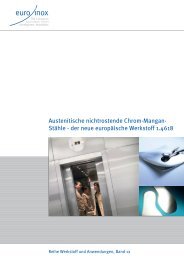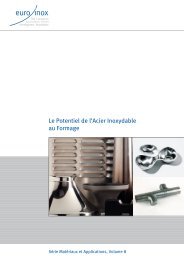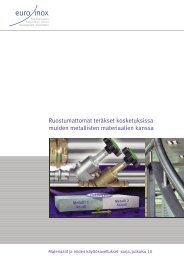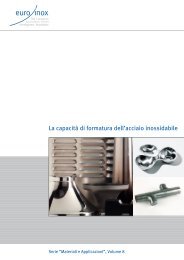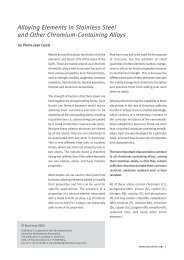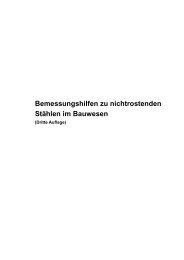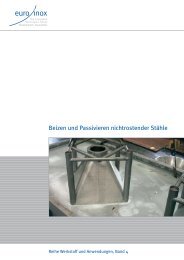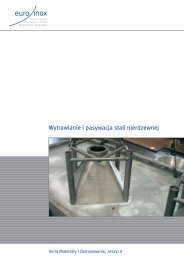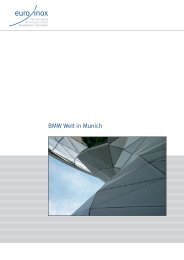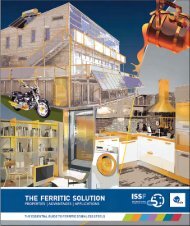Stainless Steel - The Safe Choice - Euro Inox
Stainless Steel - The Safe Choice - Euro Inox
Stainless Steel - The Safe Choice - Euro Inox
Create successful ePaper yourself
Turn your PDF publications into a flip-book with our unique Google optimized e-Paper software.
SAFE STAINLESS STEEL<br />
1. A very low nickel release (less than 0.05<br />
µg/cm2 /week at pH 4.5 and 6.6 ) close to<br />
the detection limit and which must be considered<br />
as harmless according to the <strong>Euro</strong>pean<br />
Directive 94/27/EC. This group<br />
includes the three low-sulphur stainless<br />
steel grades (AISI 430, 304 and 316L).<br />
2. An intermediate nickel release, close to<br />
the 0.5 µg/cm2 /week value which is considered<br />
as the limit for a positive reaction<br />
in already Ni-sensitised persons, following<br />
a prolonged contact with skin. This was for<br />
the resulphurised grade (AISI 303).<br />
Grade<br />
AISI 304/1.4301<br />
Domain of<br />
passivity<br />
Current density Grouping<br />
AISI 316L/1.4404 Yes < 1µA/cm2 1<br />
AISI 303/1.4305 No > 1mA/cm2 2<br />
Ni-plated steel No >> 1mA/cm2 3<br />
Table 2: Electrochemical<br />
behaviour in a synthetic<br />
sweat solution of pH 4.5<br />
at 23°C<br />
3. A high release (75 µg/cm2 /week) which<br />
probably will be harmful in case of prolonged<br />
contact of the material with skin.<br />
<strong>The</strong> Ni-plated steel belongs to that group.<br />
<strong>The</strong> results of leaching experiments correlate<br />
with those from the electrochemical (polarisation)<br />
tests which show that in synthetic<br />
sweat solutions:<br />
1. <strong>The</strong> low-sulphur stainless steel AISI 304<br />
and 316L grades (i.e. standard austenitic<br />
grades) have excellent corrosion resistance,<br />
characterised by the presence of<br />
a passive domain.<br />
2. By comparison the resulphurised stainless<br />
steel (AISI 303) and Ni-plated steel<br />
have poor corrosion resistance. <strong>The</strong>y present<br />
no passive domain in this medium<br />
of synthetic sweat.<br />
From these experiments it can be concluded<br />
that there is no corrosion and correspondingly<br />
negligible cation migration for AISI 304 and<br />
316L grades. In comparison for AISI 303 grade<br />
and even more for the Ni-plated steel the current<br />
density is high (more than 1 mA/cm2 ) indicating<br />
an active state and consequently<br />
cation migration. <strong>The</strong> result of electrochemical<br />
investigations are summa-rised in Table 2.<br />
Results of clinical patch tests clearly show<br />
that standard austenitic stainless steel (AISI<br />
304/1.4301 and 316L/1.4404) and the ferritic<br />
grade (AISI 430/1.4016 : Ni-free 17 %<br />
Cr) stainless steel are harmless since no allergic<br />
reaction was seen on the 50 already Nisensitised<br />
persons. In contrast, the resulfurised<br />
austenitic stainless steel (AISI<br />
303/1.4305) induces allergic reaction for a<br />
few persons (14 %) and the Ni-plated steel for<br />
nearly all the persons (96 %).<br />
<strong>The</strong> correlation between leaching experiments,<br />
electrochemical investigations and<br />
clinical patch test validate the value of 0.5<br />
µg/cm2 /week as a limit of nickel release in<br />
a synthetic sweat solution. Table 3 summarises<br />
the situation.<br />
© <strong>Euro</strong> <strong>Inox</strong> 2002 www.euro-inox.org · 6



